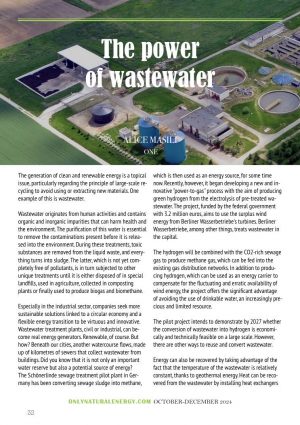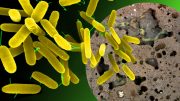 The generation of clean and renewable energy is a topical issue, particularly regarding the principle of large-scale recycling to avoid using or extracting new materials. One example of this is wastewater.
The generation of clean and renewable energy is a topical issue, particularly regarding the principle of large-scale recycling to avoid using or extracting new materials. One example of this is wastewater.
Wastewater originates from human activities and contains organic and inorganic impurities that can harm health and the environment. The purification of this water is essential to remove the contaminations present before it is released into the environment. During these treatments, toxic substances are removed from the liquid waste, and everything turns into sludge. The latter, which is not yet completely free of pollutants, is in turn subjected to other unique treatments until it is either disposed of in special landfills, used in agriculture, collected in composting plants or finally used to produce biogas and biomethane.
Especially in the industrial sector, companies seek more sustainable solutions linked to a circular economy and a flexible energy transition to be virtuous and innovative.
Wastewater treatment plants, civil or industrial, can become real energy generators. Renewable, of course. But how? Beneath our cities, another watercourse flows, made up of kilometres of sewers that collect wastewater from buildings. Did you know that it is not only an important water reserve but also a potential source of energy?
The Schönerlinde sewage treatment pilot plant in Germany has been converting sewage sludge into methane, which is then used as an energy source, for some time now. Recently, however, it began developing a new and innovative “power-to-gas” process with the aim of producing green hydrogen from the electrolysis of pre-treated wastewater. The project, funded by the federal government with 3.2 million euros, aims to use the surplus wind energy from Berliner Wasserbetriebe’s turbines. Berliner Wasserbetriebe, among other things, treats wastewater in the capital.
The hydrogen will be combined with the CO2-rich sewage gas to produce methane gas, which can be fed into the existing gas distribution networks. In addition to producing hydrogen, which can be used as an energy carrier to compensate for the fluctuating and erratic availability of wind energy, the project offers the significant advantage of avoiding the use of drinkable water, an increasingly precious and limited resource.
The pilot project intends to demonstrate by 2027 whether the conversion of wastewater into hydrogen is economically and technically feasible on a large scale. However, there are other ways to reuse and convert wastewater.
Energy can also be recovered by taking advantage of the fact that the temperature of the wastewater is relatively constant, thanks to geothermal energy. Heat can be recovered from the wastewater by installing heat exchangers connected to heat pumps in the sewage system, which flows for kilometres under the surface of our cities’ streets.
The water discharged from households is relatively constant throughout the year, as the heating water produced in the household is discharged into the wastewater collectors while still hot. The heat exchanger then recovers the heat energy contained in the water before the temperature is brought to the desired level via the heat pump. This way, wastewater can be used as a heat source in winter and for room cooling in summer.
Belgium, where the temperature is between 10° and 14°C, is focusing on the potential, technical constraints and possible profitability of this type of system. In the meantime, the first concrete applications are already making it possible to analyze the advantages of this form of energy recovery.
The first large-scale installation is that of Uccle. As part of the sewer renovation, heat exchangers were installed that can be used to air-condition the five municipal administration buildings by reheating them.
The water supply company Vivaqua, which has patented this technology, has installed a system in the Brussels city council’s sewerage plant that generates 120 kW of electricity with an eco-efficiency of almost 5. This means that the energy extracted and the energy returned are the same.
Recent studies on recovering thermal energy from wastewater in Italy measured temperatures between 15°C and 25°C. The potential of this innovative technology for wastewater was examined by Enea, which activated a case study in a wastewater section of the city of Bologna. The study showed that “the recovery of thermal energy from wastewater can significantly contribute to achieving energy neutrality in the water supply sector.
The application of recovery technologies is an interesting solution to promote the transition to new energy systems and meet the challenges of climate change”.
However, the system has several critical points. Not too much heat must be removed from the water, as this could weaken the purification process. In addition, a large and relatively constant flow of water must be guaranteed, and the possibility of incrustations in the heat exchangers due to wastewater must be taken into account.
Considering the impact of inflation, rising energy prices, and climate change, it is essential to embark on a path of change. Thanks to a mix of technological and renewable innovations, optimizing energy consumption by making production processes as circular as possible is now conceivable.
As these technologies consolidate, the synergistic integration between the energy and wastewater treatment sectors could lead to tangible economic benefits for citizens and contribute to the development of a more sustainable and resilient energy market.
Alice Masili


